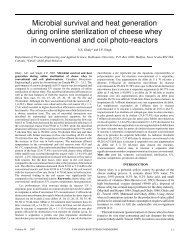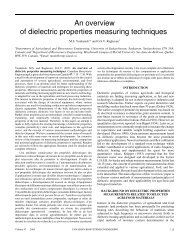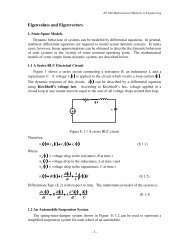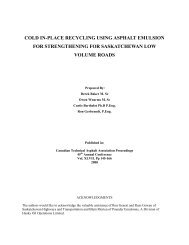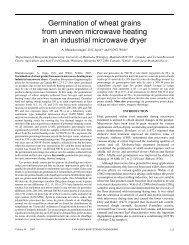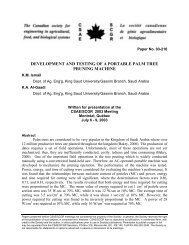Full Depth Cold-in-Place Recycling/Stabilization for Low Volume ...
Full Depth Cold-in-Place Recycling/Stabilization for Low Volume ...
Full Depth Cold-in-Place Recycling/Stabilization for Low Volume ...
Create successful ePaper yourself
Turn your PDF publications into a flip-book with our unique Google optimized e-Paper software.
effect, trial and error methods. As a result, public road agencies have been reluctant to use<br />
stabilization <strong>in</strong> anyth<strong>in</strong>g other than small trial applications, even though the potential economic<br />
and environmental benefits of stabilized road systems can be quite compell<strong>in</strong>g. Recent<br />
developments <strong>in</strong> thermomechanistic and physiochemical characterization and mechanistic road<br />
model<strong>in</strong>g of roads have the potential to overcome the limited predictive capabilities associated<br />
with traditional phenomenological-empirical methods and provide road eng<strong>in</strong>eers with a rational<br />
framework to defensibly evaluate stabilized road systems. A mechanistic framework will reduce<br />
the uncerta<strong>in</strong>ty associated with the per<strong>for</strong>mance of stabilized road systems <strong>in</strong> diverse<br />
applications.<br />
5.0 SUMMARY AND CONCLUSIONS<br />
Saskatchewan Highways and Transportation (SHT) is responsible <strong>for</strong> ma<strong>in</strong>ta<strong>in</strong><strong>in</strong>g approximately<br />
8600 kilometers of th<strong>in</strong> membrane surface (TMS) roads. Many of these TMS roads are<br />
experienc<strong>in</strong>g added pressures from the recent rationalization of the prov<strong>in</strong>cial gra<strong>in</strong> handl<strong>in</strong>g<br />
transportation system plus other heavy haul dependent <strong>in</strong>dustries. Un<strong>for</strong>tunately, the<br />
Saskatchewan TMS system was never designed to handle the <strong>in</strong>creased loads and traffic. As a<br />
result, the TMS system is deteriorat<strong>in</strong>g with limited resources to improve or ma<strong>in</strong>ta<strong>in</strong> exist<strong>in</strong>g<br />
conditions <strong>in</strong> an expected timely fashion. To <strong>in</strong>crease timely repair or structural strengthen<strong>in</strong>g<br />
these roads require new and <strong>in</strong>novative measures result<strong>in</strong>g <strong>in</strong> more cost-effective and efficient<br />
treatments. The work on Highway No. 19 is a step towards fulfill<strong>in</strong>g this goal.<br />
The economic viability <strong>for</strong> the prov<strong>in</strong>ce of Saskatchewan is dependent upon its transportation<br />
system. The condition of the transportation network has a direct impact on the economic stability<br />
of the prov<strong>in</strong>ce. SHT <strong>in</strong>tends to provide a susta<strong>in</strong>able transportation system <strong>for</strong> its users and<br />
stakeholders. Current changes <strong>in</strong> gra<strong>in</strong> handl<strong>in</strong>g and other major <strong>in</strong>dustries like oil and <strong>for</strong>estry<br />
have placed considerable pressure on the highway network, particularly the secondary road<br />
system. Although conventional rehabilitation methods are proven, more economical techniques<br />
are required <strong>in</strong> order to provided timely repair or rehabilitation of the secondary highway<br />
network.<br />
Based on the f<strong>in</strong>d<strong>in</strong>gs of this study, cold <strong>in</strong>-place recycl<strong>in</strong>g <strong>in</strong> conjunction with stabilization<br />
systems may prove to be a viable treatment alternative <strong>for</strong> the prov<strong>in</strong>ce. If sav<strong>in</strong>gs can be<br />
realized due to reduced aggregate usage, while at the same time, provid<strong>in</strong>g a strengthened<br />
subgrade that can carry more tones over a few years prior to full upgrad<strong>in</strong>g. The pilot project on<br />
Highway 19-06 will cont<strong>in</strong>ue to be monitored to quantify the long-term per<strong>for</strong>mance <strong>for</strong> each<br />
test site. Other projects will be completed and other products evaluated to identify other possible<br />
treatment options. SHT will cont<strong>in</strong>ue to research, develop, and implement new methods <strong>for</strong><br />
preserv<strong>in</strong>g the prov<strong>in</strong>cial roadway network.<br />
18



